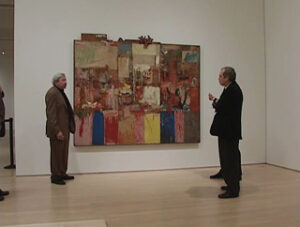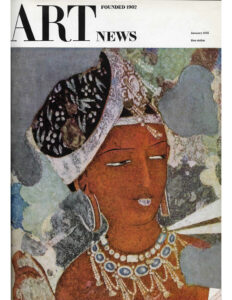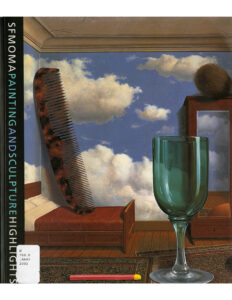Ownership History
David Myers, New York, purchased between 1955 and 19581
Ileana Sonnabend, New York and Paris, purchased ca. 19602
San Francisco Museum of Modern Art, purchased for the museum by Harry W. and Mary Margaret Anderson, 1972
- Myers purchased the work directly from Rauschenberg but did not record and does not recall the date of that transaction; he is certain he had taken possession of it by 1958. Myers, interview with Sarah Roberts, October 2011.
- The exact year of the work’s transfer from Myers to Sonnabend cannot be determined. In a letter in SFMOMA’s Permanent Collection Object Files dated October 29, 1983, Sonnabend notes that she purchased the painting from Myers in 1959 or 1960. However, records in the Robert Rauschenberg Foundation archives date Sonnabend’s purchase to 1961 or 1962. In a July 4, 1958, telegram in the Leo Castelli Gallery papers, Sonnabend asks Castelli: “DID YOU QUOTE PRICE MYERS PICTURE?” Leo Castelli Gallery Records, ca. 1880–2000, bulk 1957–1990. Archives of American Art, Smithsonian Institution, Washington, D.C. Because the work was untitled at that time, it is generally referred to in correspondence and notes from those years as the “Myers piece” or “Myers picture.” The dimensions noted in the telegram confirm that the unnamed work in question is Collection. This telegram also suggests that Myers and Sonnabend had begun to negotiate the sale of the work; no receipts have been found to date the actual transfer of ownership. Handwritten lists in the Castelli Gallery Records show Castelli allocating Rauschenberg’s works between Sonnabend and himself in November 1961 as she prepared to leave New York for Paris, some two years after their divorce. The first concrete documentation of Sonnabend’s ownership of Collection is a loan form from the Solomon R. Guggenheim Museum for the 1963 exhibition Six Painters and the Object.
Exhibition History
Bob Rauschenberg, Charles Egan Gallery, December 1954–January 18, 1955. This exhibition is generally referred to in the literature as Red Paintings and Combines. The exact start date has not been documented, but it likely opened after December 4, 1954.
Window display for the Annual Young American Artists’ Window Exhibit, Bonwit Teller, New York, ca. late January 1957. Collection was shown under the title Victoria.
Six Painters and the Object, Solomon R. Guggenheim Museum, New York, March 14–June 12, 1963. Did not travel to remaining venues.
Painting and Sculpture of a Decade, 1954–1964, Tate Gallery, London, April 22–June 28, 1964.
Robert Rauschenberg, Museum Haus Lange, Krefeld, West Germany, September 12–October 18, 1964.
Robert Rauschenberg: Untitled 1953–54 and Thirty-Four Dante Drawings, Galerie Ileana Sonnabend, Paris, December 1964–January 13, 1965.
Robert Rauschenberg, Stedelijk Museum, Amsterdam, February 23–April 7, 1968. Traveled to: Kölnischer Kunstverein, Cologne, Germany, April 19–May 26, 1968; Musée d’Art Moderne de la Ville de Paris (as Rauschenberg, Oeuvres de 1949 à 1968), October 10–November 10, 1968.
II. Biennale Nürnberg, “Was die Schönheit sei, das weiß ich nicht: Künstler–Theorie–Werk,” Kunsthalle Nürnberg, Germany, April 30–August 1, 1971.
Untitled installation, University of Iowa Museum of Art, Iowa City, May 24–August 24, 1972.
Poets of the City: New York and San Francisco, 1950–1965, San Francisco Museum of Art, January 31–March 23, 1975. Did not travel to remaining venues.
Robert Rauschenberg, National Collection of Fine Arts, Smithsonian Institution, Washington, D.C., October 30, 1976–January 2, 1977. Traveled to: Museum of Modern Art, New York, March 25–May 17, 1977; San Francisco Museum of Modern Art, June 24–August 21, 1977; Albright-Knox Art Gallery, Buffalo, September 25–October 30, 1977; Art Institute of Chicago, December 3, 1977–January 15, 1978.
Aesthetics of Graffiti, San Francisco Museum of Modern Art, April 28–July 2, 1978.
Facets of the Collection: Masterpieces and Recent Acquisitions, San Francisco Museum of Modern Art, August 14–November 15, 1981.
Resource/Reservoir: Collage and Assemblage, San Francisco Museum of Modern Art, July 30–September 26, 1982.
American Painting: Abstract Expressionism and After, San Francisco Museum of Modern Art, February 14, 1986–August 30, 1987.
The Anderson Collection Gift of American Pop Art, San Francisco Museum of Modern Art, February 4–May 30, 1993.
Robert Rauschenberg: A Retrospective, Solomon R. Guggenheim Museum, New York, September 19, 1997–January 7, 1998. Did not travel to remaining venues.
Robert Rauschenberg, San Francisco Museum of Modern Art, May 7–September 7, 1999.
Celebrating Modern Art: The Anderson Collection, San Francisco Museum of Modern Art, October 7, 2000–January 15, 2001 (on view October 7, 2000–January 21, 2001).
Robert Rauschenberg: Combines, Metropolitan Museum of Art, New York, December 20, 2005–April 2, 2006. Traveled to: Museum of Contemporary Art, Los Angeles, May 21–September 4, 2006. Did not travel to remaining venues.
75 Years of Looking Forward: The Anniversary Show, San Francisco Museum of Modern Art, December 19, 2009–January 16, 2011.
Pop Art from the Anderson Collection at SFMOMA, Iris & B. Gerald Cantor Center for the Visual Arts, Stanford University, August 13, 2014–October 26, 2015.
In addition to appearing in the special exhibitions listed above, Collection has been on view in SFMOMA’s galleries nearly continuously since 1972 as part of an ongoing series of rotating presentations of the permanent collection.
This listing has been updated since the launch of the Rauschenberg Research Project and is complete as of August 31, 2016.
Publication History
Frank O’Hara, “Bob Rauschenberg,” ARTnews 53, no. 9 (January 1955): 47 (ill.).
Öyvind Fahlström, “En gata full av presenter,” Konstrevy 37, nos. 5–6 (1961): 180, 181 (ill.).
Donald Judd, “Six Painters and the Object,” Arts Magazine 37, no. 9 (May–June 1963): 109.
“Pop Art—Cult of the Commonplace,” Time, May 3, 1963, 71 (ill. as Untitled).
Barbara Rose, “Pop Art at the Guggenheim,” Art International 7, no. 5, May 25, 1963, 20.
Painting and Sculpture of a Decade, 1954–1964 (London: Calouse Gulbenkian Foundation [in association with the Tate Gallery], 1964), 229 (ill.).
Robert Rauschenberg (Krefeld, Germany: Museum Haus Lange, 1964), n.p. (ill.).
Anita Brookner, “London,” Burlington Magazine 106, no. 735 (June 1964): 298 (as Untitled, cat. 286).
Robert Rauschenberg, with an introduction by Andrew Forge (Amsterdam: Stedelijk Museum, 1968), 18 (ill.).
Robert Rauschenberg: Oeuvres de 1949 à 1968 (Paris: Musée d’Art Moderne de la Ville de Paris, 1968), n.p.
Andrew Forge, Rauschenberg (New York: Harry N. Abrams, 1969), 31, 175 (ill. listed as Untitled).
Janni Müller-Hauck, Heinz Neidel, and Eberhard Roters, eds., Was die Schönheit sei, das weiß ich nicht: Künstler–Theorie–Werk (Cologne: M. DuMont Schauberg, 1971), 130 (ill.).
Andrew Forge, Rauschenberg (New York: Harry N. Abrams, 1972), n.p. (ill. listed as Untitled).
“Two new abstract works at gallery,” Daily Iowan (Iowa City), June 6, 1972.
Brian O’Doherty, “Rauschenberg and the Vernacular Glance,” Art in America 61, no. 5 (September–October 1973): 86 (ill.).
Walter Hopps, ed., Robert Rauschenberg (Washington, D.C.: National Collection of Fine Arts, Smithsonian Institution, 1976), 5, 8, 10 (ill.), 11 (ill.), 77 (ill.).
Robert Hughes, “The Most Living Artist,” Time, November 29, 1976, 54, 56 (ill.), 60.
Jeff Perrone, “Robert Rauschenberg,” Artforum 15, no. 6 (February 1977): 24.
Charles F. Stuckey, “Reading Rauschenberg,” Art in America 65, no. 2 (March–April 1977): 81.
John Russell, “Art That Sings: A Rauschenberg Retrospective,” New York Times, March 25, 1977.
Harold Rosenberg, “The Art World: Souvenirs of an Avant-Garde,” New Yorker, May 16, 1977, 125–26.
Walter Blum, “A One-Man Mainstream,” California Living, June 19, 1977, 25 (ill.).
Henry J. Seldis, “Rauschenberg Retrospective: Robert’s Rules of Disorder,” Los Angeles Times, June 24, 1977.
Julia Cheever, “Looking Back on a Giant of Modern Art,” San Francisco Bay Guardian, July 14, 1977.
Rolando Castellón, ed., Aesthetics of Graffiti (San Francisco: San Francisco Museum of Modern Art, 1978), n.p. (ill.).
Devonna Pieszak, “Robert Rauschenberg: From Port Arthur to Captiva,” New Art Examiner 5, no. 4 (January 1978): 3.
Alfred Frankenstein, “Graffiti Take the Floor,” San Francisco Chronicle, May 4, 1978.
Charles Shere, “Graffiti—More than a Public Nuisance, to Eye of an Artist,” Oakland Tribune, May 7, 1978.
Cathy Curtis, “Off the Wall,” Daily Californian, June 2, 1978.
Robert Rauschenberg: Retrospective, directed by Michael Blackwood (New York: Michael Blackwood Productions, 1979), VHS, 45 min.
Götz Adriani, Robert Rauschenberg: Zeichnungen, Gouachen, Collagen 1949 bis 1979 (Munich: R. Piper & Co. Verlag, 1979), 7.
Arthur Perry, “Rauschenberg Meets Standard in Exhibition,” Artmagazine (Toronto) 11, no. 45 (September/October 1979): 42.
Dieter Ruckhaberle, ed., Rauschenberg: Werke 1950–1980, trans. Janni Müller-Hauck and Vincent Thomas (Berlin: Staatliche Kunsthalle Berlin, 1980), 40, 42, 43, 49, 51, 54.
Karen Tsujimoto, Resource/Reservoir: Collage and Assemblage (San Francisco: San Francisco Museum of Modern Art, 1982), n.p. (ill.).
Rauschenberg (Madrid: Fundación Juan March, 1985), n.p.
San Francisco Museum of Modern Art: The Painting and Sculpture Collection (San Francisco: San Francisco Museum of Modern Art, 1985), 194, 195 (ill.), 255, 361 (ill.).
Roni Feinstein, “Random Order: The First Fifteen Years of Robert Rauschenberg’s Art, 1949–1964” (PhD diss., New York University, 1990), vi, 165–69, 172–74, 186n27, 188n33.
Roger Bevan, “San Francisco: Salvaging 1950s Rauschenberg,” Art Newspaper 3, no. 18 (May 1992): 7.
ラウシェンバーグ [Rauschenberg], Gendai bijutsu 14 (Tokyo: Kodansha, 1993), n.p. (ill.).
Kirk Varnedoe, ed., Jasper Johns: A Retrospective (New York: Museum of Modern Art, 1996), 95 (ill.).
Lisa Wainwright, “Robert Rauschenberg’s Fabrics: Reconstructing Domestic Space,” in Not at Home: The Suppression of Domesticity in Modern Art and Architecture, ed. Christopher Reed (London: Thames and Hudson, 1996), 198, 201.
Walter Hopps and Susan Davidson, eds., Robert Rauschenberg: A Retrospective (New York: Solomon R. Guggenheim Museum, 1997), 103 (ill.).
Roni Feinstein, “Rauschenberg: Solutions for a Small Planet,” Art in America 86, no. 2 (February 1998): 69.
Diane Haithman, “S.F. Museum of Modern Art Goes on a Buying Spree,” Los Angeles Times, June 6, 1998.
Kenneth Baker, “Rauschenberg’s Reality,” San Francisco Chronicle, August 20, 1998, (ill.).
Sam Hunter, Robert Rauschenberg (New York: Rizzoli, 1999), 21 (ill.), 125.
Joachim Jäger, Das zivilisiert Bild: Robert Rauschenberg und seine Combine-Paintings der Jahre 1960–1962 (Klagenfurt, Austria: Ritter Verlag, 1999), 23, 25 (ill.), 53.
Robert Rauschenberg, video interview by David A. Ross, Walter Hopps, Gary Garrels, and Peter Samis, San Francisco Museum of Modern Art, May 6, 1999. Unpublished transcript, SFMOMA Research Library and Archives, N 6537 .R27 A35 1999a, 40–41, 52–57.
Kenneth Baker, “Rauschenberg Coup at SFMOMA: ‘Port of Entry’ a Major New Work,” San Francisco Chronicle, May 8, 1999.
David Bonetti, “Rauschenberg Coup Cements SFMOMA’s Ascendance,” San Francisco Examiner, May 28, 1999.
Gary Garrels, ed., Celebrating Modern Art: The Anderson Collection (San Francisco: San Francisco Museum of Modern Art, 2000), 10 (ill.), 24, 31n26, 38, 46, 53 (ill.), 54–55, 90 (ill.), 382.
SFMOMA Painting and Sculpture Highlights (San Francisco: San Francisco Museum of Modern Art, 2002), n.p. (ill.).
Branden W. Joseph, Random Order: Robert Rauschenberg and the Neo-Avant-Garde (Cambridge, MA: MIT Press, 2003), 75, 76 (ill.), 78, 95, 104–107, 110, 111 (ill.), 112, 114, 116–17, 119, 139, 142, 144, 168, 191, 313n6–8.
Robert Saltonstall Mattison, Robert Rauschenberg: Breaking Boundaries (New Haven, CT: Yale University Press, 2003), 39, 41, 45, 57, 58 (ill.), 59 (ill.), 60, 61 (ill.), 62, 75, 263n41.
Susan Davidson and David White, eds., Rauschenberg (Ferrara, Italy: Ferrara Arte, 2004), 71n15.
Paul Schimmel, ed., Robert Rauschenberg: Combines (Los Angeles: Museum of Contemporary Art, 2005), 20 (ill.), 21 (ill.), 211, 215–18, 227, 288.
Rosetta Brooks, “Round the Block Once or Twice: A Conversation with Rosetta Brooks,” Modern Painters (December 2005–January 2006): 70 (ill.)
Mark A. Cheetham, Abstract Art Against Autonomy: Infection, Resistance, and Cure Since the ’60s (Cambridge: Cambridge University Press, 2006), 49, 50, 51 (ill.), 52.
Sam Hunter, Robert Rauschenberg: Works, Writings and Interviews (Barcelona: Ediciones Polígrafa, 2006), 29.
Lytle Shaw, Frank O’Hara: The Poetics of Coterie (Iowa City: University of Iowa Press, 2006), 195.
Jerry Saltz, “Our Picasso?,” Artnet, January 11, 2006, n.p. (ill.). Accessed June 23, 2013. https://www.artnet.com/magazineus/features/saltz/saltz1-11-06.asp#.
Yve-Alain Bois, “Eye to the Ground,” Artforum 44, no. 7 (March 2006): 246 (ill.), 247.
Branden W. Joseph, “The Gap and the Frame,” October 117 (Summer 2006): 48.
Frances Colpitt, “Compound Pleasures,” Art In America 94, no. 11 (December 2006): 100.
Jonathan D. Katz, “Reading Watchman through the Archive,” Archives of American Art Journal 46 (Fall 2007): 34.
Mirta D’Argenzio, ed., Robert Rauschenberg: Travelling ’70|’76 (Milan: Electa, 2008), 154–55, 156–57 (ill.), 243.
Bruno Marchand, ed., Robert Rauschenberg: Crítica e obra de 1949 a 1974 (Porto, Portugal: Fundação de Serralves, 2008), 24, 26, 83 (ill.), 94, 95, 96, 100.
Ann Temkin, ed., Color Chart: Reinventing Color, 1950 to Today (New York: Museum of Modern Art, 2008), 60 (ill.).
Jonathan D. Katz, “‘Committing the Perfect Crime’: Sexuality, Assemblage, and the Postmodern Turn in American Art,” Art Journal 67, no. 1 (Spring 2008): 46.
Willibald Sauerländer, “Im Schutt der Industriegesellschaft,” Süddeutsche Zeitung (Munich), May 13, 2008.
Jonathan D. Katz, “The Outness of Rauschenberg’s Art,” Gay & Lesbian Review 15, no. 5 (September–October 2008): 11.
“SFMOMA 75th Anniversary: Neal Benezra,” interview conducted by Richard Cándida Smith and Lisa Rubens, 2007–8, Regional Oral History Office, The Bancroft Library, University of California, Berkeley, 2009, 9. Accessed June 23, 2013. https://bancroft.berkeley.edu/ROHO/projects/sfmoma/interviews.html.
“SFMOMA 75th Anniversary: Peter Samis,” interview conducted by Jess Rigelhaupt, 2008, Regional Oral History Office, The Bancroft Library, University of California, Berkeley, 2009, 25. Accessed June 23, 2013. https://bancroft.berkeley.edu/ROHO/projects/sfmoma/interviews.html.
Janet Bishop, Corey Keller, and Sarah Roberts, eds., San Francisco Museum of Modern Art: 75 Years of Looking Forward (San Francisco: San Francisco Museum of Modern Art, 2009), 144 (ill.), 148, 149, 432.
Carolyn Lanchner, Robert Rauschenberg (New York: Museum of Modern Art, 2009), 19 (ill.).
“SFMOMA 75th Anniversary: David White,” interview conducted by Richard Cándida Smith, Sarah Roberts, Peter Samis, and Jill Sterrett, 2009, Regional Oral History Office, The Bancroft Library, University of California, Berkeley, 2010, 30, 36, 44, 73–74, 75. Accessed June 23, 2013. https://bancroft.berkeley.edu/ROHO/projects/sfmoma/interviews.html.
Tom Folland, “Robert Rauschenberg’s Queer Modernism: The Early Combines and Decoration,” Art Bulletin 92, no. 4 (December 2010): 351, 352 (ill.), 355, 358, 359.
James Boaden, “Black Painting (with Asheville Citizen),” Art History 34, no. 1 (February 2011): 186.
Catherine Craft, “In need of repair: the early exhibition history of Robert Rauschenberg’s Combines,” Burlington Magazine 154, no. 1308 (March 2012): 191.
———, Robert Rauschenberg (London: Phaidon, 2013), 47, 54–55 (ill.).
Andrew Scott Cooper, “Did an Artwork Solve a Decades-Old NYC Crime?” New York Observer, August 19, 2014, (ill.).
Sarah Cascone, “Robert Rauschenberg Painting Helps Solve 1950s Murder,” Artnet, August 30, 2014, (ill.). Accessed September 2, 2014. https://news.artnet.com/in-brief/robert-rauschenberg-painting-helps-solve-1950s-murder-89277.
Nancy Ewart, “The Anderson Collection at Stanford Opens to the Public,” San Francisco Examiner, September 1, 2014. Accessed April 2, 2015. https://www.examiner.com/article/the-anderson-collection-at-stanford-opens-to-the-public.
Kenneth Baker, “Art Review: Robert Rauschenberg Views the Moon Mission,” San Francisco Chronicle, December 19, 2014.
Randy Kennedy, “Against the Grain, Rauschenberg Foundation Eases Copyright Rules,” New York Times, February 27, 2016, (ill.).
Thomas Marks, “Three cheers for Bob Rauschenberg!” Apollo, March 24, 2016, (ill.). Accessed September 1, 2016. https://www.apollo-magazine.com/three-cheers-for-bob-rauschenberg/.
This listing has been updated since the launch of the Rauschenberg Research Project and is complete as of August 31, 2016.





























